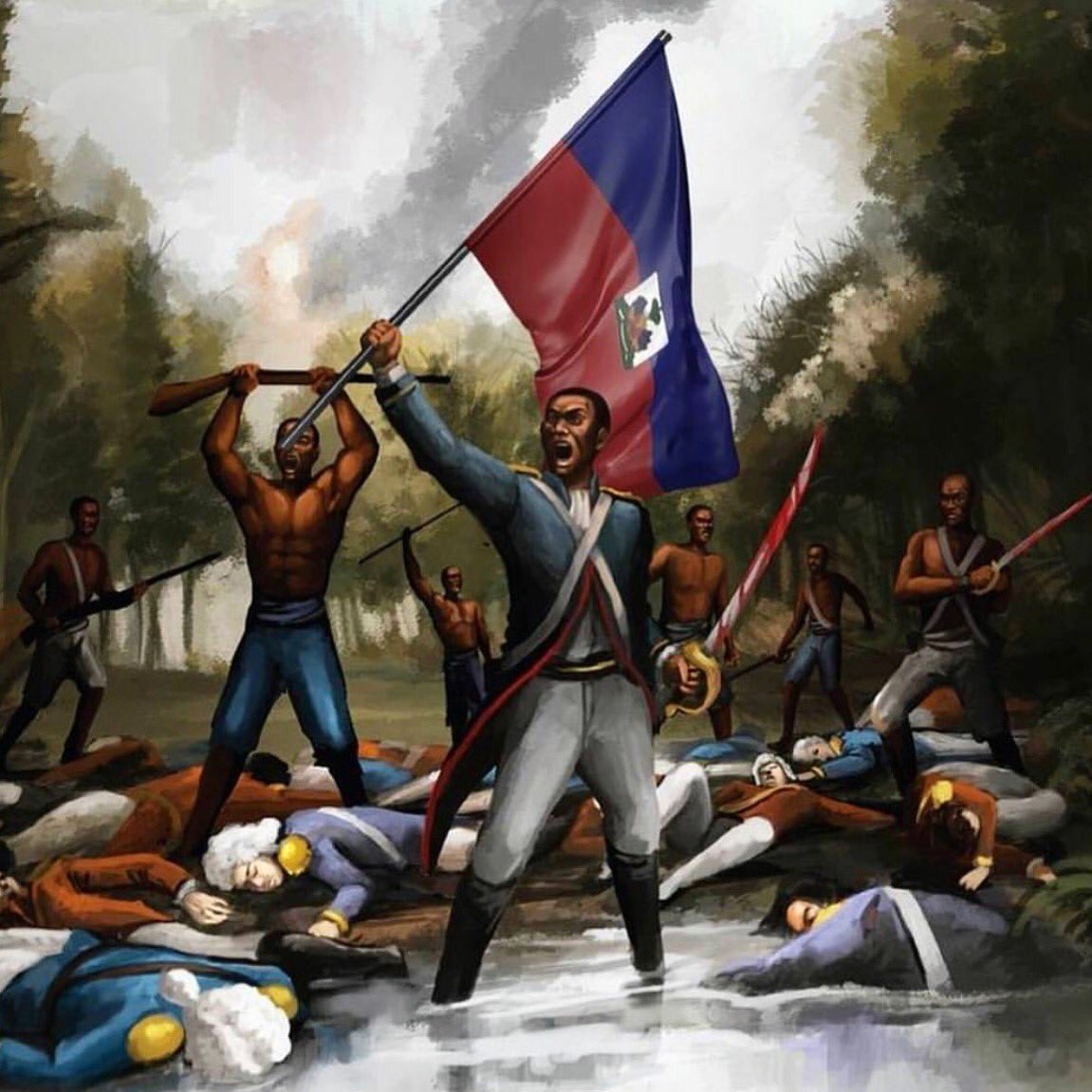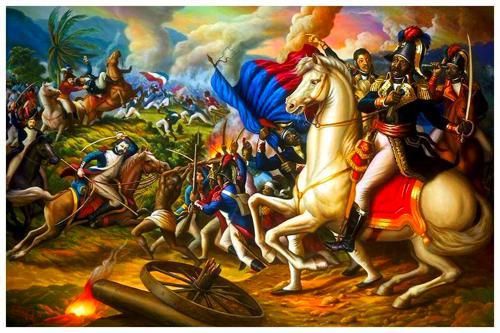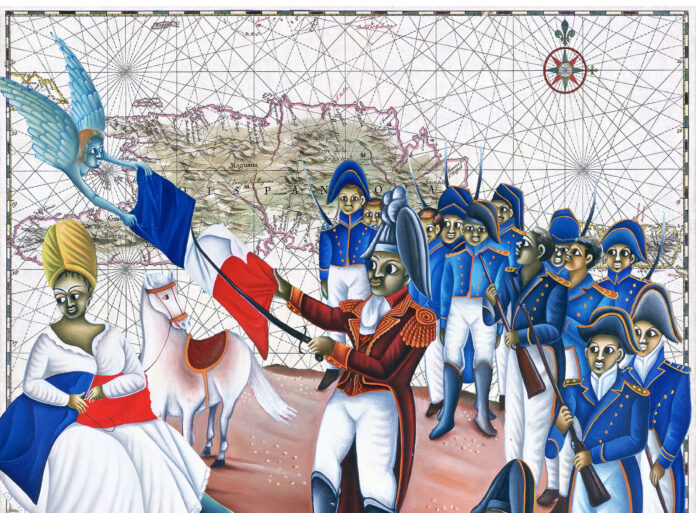January 1st is the day Haiti proclaimed herself to be a free, independent nation. She became the first free black republic in the world. Her great battle for freedom, the Haitian Revolution, is the only successful slave revolt in the history of humanity that led to the creation of a nation.
The silencing of Haitian revolution is only a chapter within a narrative of global domination. It is part of the history of the West and it is likely to persist, even in attenuated form, as long as the history of the West is not retold in ways that bring forward the perspective of the world.”
The French Revolution proclaimed liberty, equality, fraternity, implying men are born and remain free and equal in rights. But did this extend to the slaves in France’s overseas colonies? The slaveowners in the French colonies participated actively in the French Revolution, on one hand demanding equality and liberty for themselves while convinced the National Assembly to guarantee that no changes would be made in the slave system.

Haiti, in the Caribbean was first claimed by spain in 1492 and then it was seceeded to France in 1665 .Even though France’s colonies looked small on the map, the three Caribbean colonies of Saint Domingue, Guadeloupe and Martinique contained almost as many slaves as the thirteen much larger American states .
San domigues ( now republic of haiti) produced roughly 40 percent of the sugar and 60 percent of the coffee imported to Europe. The colonial economy was based almost entirely on the production of plantation crops for export. It accounted for more than one-third of the entire Atlantic slave trade.
The livelihood of 1 million of the approximately 25 million people who lived in the France in 1789 depended directly upon the agricultural imports from Saint-Domingue, and several million indirectly depended upon trade from the colony to maintain their standard of living. Saint-Domingue was the most profitable French colony in the world, and one of the most profitable of all the European colonies in the 18th century, it was called the pearl of Antilles.
Also read:2020: Global People’s Resistance against COVID and the State
The Production of sugar depended on extensive manual labor provided by enslaved Africans. In 1681 there were 2,000 African slaves and by 1789 there were almost half a million.The slave system in Saint-Domingue was regarded as one of the harshest in the Americas, with high levels of both mortality and violence where the average life expectancy for a slave was 21 years.
Over the French colony’s hundred-year course, slavery killed about a million Africans. According to the 1685 Code Noir was legal for a slaveholder to kill a slave who hit a white persons. Slaves were whipped, burned, buried alive, restrained and allowed to be bitten by swarms of insects, mutilated, raped, and limbs amputated.
French imposed a three-tiered social structure. At the top of the social and political ladder was the white elite (grands blancs). At the bottom of the social structure were the enslaved black (noirs), most of whom had been born in Africa. Between the white elite and the slaves arose a third group, the freedmen (mullatoes), most of whom were descended from unions of slave owners and slaves .Most were slaves imported from Africa.
The century of domination of white slave holders over the African women produced a subpopulation of mulattoes. The mulattoes being offspring of the white elite were given special privileges that led to mulattoes accumulating land and some wealth, paid taxes had the rights of citizens including the right to vote The mulattoes were below white elite in social status ( socially and politically inferior)but they were above the pure African slaves.
Also between the white elite and the slaves were the poor whites (petits blancs), who considered themselves socially superior to the Mulattoes, even if they sometimes found themselves economically inferior to them. Of a population of 519,000 in 1791, 87 percent were slaves, 8 percent were whites, and 5 percent were freedmen. African slaves at the plantation outnumbered the French owners and their overseers by ten to one.
In the 18th century communities of escaped slaves developed in the mountain wildernesses. These people were called maroons from the Spanish word cimaron for wild. In 1790 a group of black leaders including some maroons initiated a slave rebellion but was crushed.

Late on a night in August 1791, sugar plantation slaves in the French colony of Saint Domingue gathered at a voodoo ceremony. By the next morning, the slaves began to burn down the plantations, kill the brutal owners. Over the next few months, they set in motion the only successful slave revolt in history. Northern United States merchants and slave owners in the South felt threatened by the revolt in Haiti. News of the revolt gave hope to American slaves and deepened the fears of Southern slave owners. The Haitian Revolution propelled the idea that all men are born free and continued the quest for freedom elsewhere.
The confrontation was not just black vs white . Rebellions in the eighteen centuries were all to be inspired by the Enlightenment’s radical philosophies. The American Declaration of Independence emphasized the principle of popular sovereignty, which states that all governmental power comes from the general will of the people, a concept formulated by Rousseau.The French Declaration of the Rights of Man and Citizen announced that men were “born and remain free and equal in rights,” and enjoyed natural rights to “liberty, property, security, and resistance to oppression.”
The blacks were considered barbaric, inferior to whites, the haitain revolution shattered this belief, for the first time in the history of the New World, a slave revolt had culminated in the total defeat of white forces.The black slaves ouwited the best of generals. The struggle was not withdrawal of colonialists but their total overthrow and end to economic and political exploitation by slaves.For the first time in history, the lowest order of society -slaves became equal, free and independent citizens. Haitian revolutionaries offered a radical account of black citizenship and envisioned a world order in which both slavery and colonial rule would be transcended.
The latifundias( large landholdings) were converted to community minifundists ( small landholdings) and reoriented from export dependency to self-sufficient marketing system,despite all odds. Haiti has also had a long struggle to overcome the hostility of the outside world. The United States did not even recognize Haiti as a sovereign nation until 1862.
Arushi Kumar is a student at Jadavpur University.
(This article was first published in counter currents.org )



